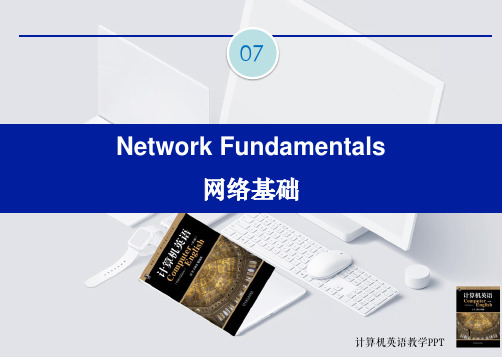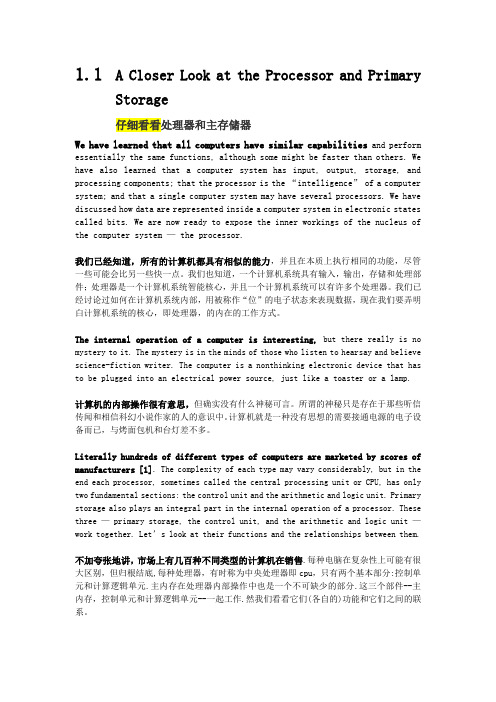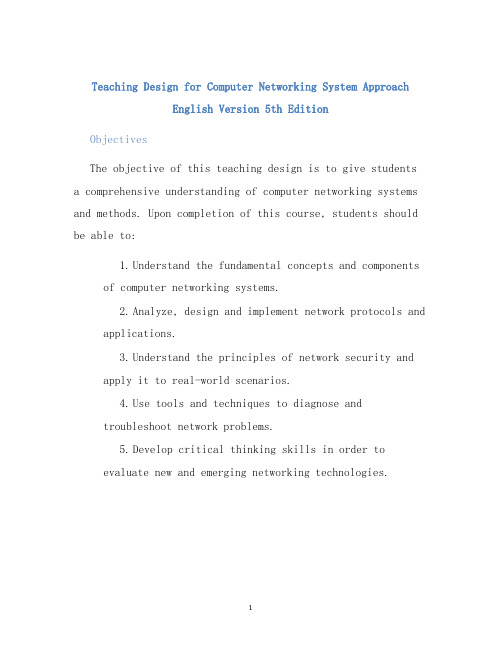计算机网络第五版(英文版)
计算机网络第五版(英文版)ppt (5)

Building Link State Packets
The packet starts with the identity of the sender, followed by a sequence number and age, and a list of dual items( neighbor, the delay to it ). The hard part is when to build them, at regular intervals or when some significant event occurs? Practice shows that once an hour is often enough.
计算机网络
The Network Layer
The Network Layer
Topics
Network Layer Design Issues
Store-and-Forward Packet Switching
Implementation of Connectionless Service
Routing Algorithm Basics
The routing algorithm is that part of the network layer software responsible for deciding which output line an incoming packet should be transmitted on. If the subnet uses datagrams internally, this decision must be made anew for every arriving data packet since the best route may have changed since last time. If the subnet uses virtual circuits internally, routing decisions are made only when a new virtual circuit is being set up.
计算机网络双语Andrew STanenbaum第五版CNchapter1

• Desktop sharing
• E-commerce
Business
applicatictions
Home applications
• Twitter • Youtube • Facebook • Ubiquitous
computing
• Smart phone • GPS • M-commerce • Wearable computer
3 Network software
Layer
Protocol
service
Connect-oriented service
Connectless service
Network architecture
3.1 Network software-layer
layer
To reduce their design complexity, most networks are organized as a stack of layers or levels, each one built upon the one below it.
Mobile users
Social issues
• Sharing problems • Piracy • Privacy • Law problems
Uses of computer networks Network hardware Network software Reference models
The purpose of each layer is to offer certain services to the higher layers while shielding those layers from the details of how the offered services are actually implemented.
谢希仁计算机网络第五版课件CH9-5ed 无线网络

最高数据率较高,支持更多用户 同时上网,价格最高,信号传播 距离较短,且易受阻碍
最高数据率较高,支持更多用户 同时上网,信号传播距离最远, 且不易受阻碍,价格比 802.11b 贵
高校教育精品PPT 20
9.1.3 802.11 局域网的 MAC 层协议
便携接入(portable access)——在受限的网络 覆盖面积中,用户设备能够在以步行速度移动 时进行网络通信,提供有限的切换能力。
游牧接入(nomadic access)——用户设备的地 理位置至少在进行网络通信时保持不变。如用 户设备移动了位置,则再次进行通信时可能还 要寻找最佳的基站
CSMA/CA 协议
无线局域网不能使用 CSMA/CD, 而只能使用改进的 CSMA 协议。
改进的办法是把 CSMA 增加一个碰撞 避免(Collision Avoidance)功能。
802.11 就使用 CSMA/CA 协议。而在 使用 CSMA/CA 的同时,还增加使用 停止等待协议。
下面先介绍 802.11 的 MAC 层。
高校教育精品PPT 2
9.1 无线局域网
9.1.1 无线局域网的组成
有固定基础设施的无线局域网
AP1
AP2
高校教育精品PPT 3
一个基本服务集 BSS 包括一个基站和若干个移动站, 所有的站在本 BSS 以内都可以直接通信, 但在和本 BSS 以外的站通信时 , 都要通过本 BSS 的基站。
AP1
其实 B 向 A 发送数据并不影响 C 向 D 发送数据
这就是暴无露站线问局题(域exp网os的ed特sta殊tion问pr题oblem)
B 的作用范围
计算机网络英文版习题答案

P63 #5 Consider sending a packet of F bits over a path of Q links. Each link transmits at R bps. The network is lightly loaded so that there are no queuing delays. Propagation delay is negligible.a.Suppose the network is a packet-switched virtual-circuit network. Denote the VC setup time by t s seconds. Suppose the sending layers add a total of h bits of header to the packet. How long does it take to send the file from source to destination?t s+[(F+h)/R]Qb.Suppose the network is a packet-switched datagram network and a connectionless service is used. Now suppose each packet has 2h bits of header. How long does it take to send the packet?[(F+2h)/R]Qc.Finally, suppose that the network is a circuit-switched network. Further suppose that the transmission rate of the circuit between source and destination is R bps. Assuming ts setup time and h bits of header appended to the packet, how long does it take to send the packet?t s+(F+h)/RP64 #6 This elementary problem begins to explore propagation delay and transmission delay, two central concepts in data networking. Consider two hosts, A and B, connected by a single link of rate R bps. Suppose that the two hosts are separated by m meters and suppose that the propagation speed along the link is s meters/sec. Host A sends a packet of size L bits to host B.[a] Express the propagation delay, d prop, in terms of m and s.[b] Determine the transmission time of the packet, d trans, in terms of L and R.[c] Ignoring processing and queueing delays, obtain an expression for the end-to-end delay.[d] Suppose Host A begins to transmit the packets at time t=0. At time t=d trans, where is the last bit of the packet?[e] Suppose d prop is greater than d trans. At time t=d trans, where is the first bit of the packet?[f] Suppose d prop is less than d trans. At time t=d trans, where is the first bit of the packet?[g] Suppose s=2.5 x 108, L=100 bits and R=28kbps. Find the distance m so that d prop = d trans.[a] d prop = m/s[b] d trans = L/R[c] end-to-end delay = d prop + d trans=m/s+L/R[d] The beginning position of the link.[e] On the channel between A and B.[f] On the host B.[g] m/s = L/R = > m = sL/R = > m = 892.86 kmP65 #10 Consider the queueing delay in a router buffer. Suppose that all packets are L bits, the transmission rate is R bps, and that N packets simultaneously arrive at the buffer every LN/R seconds. Find the average queueing delay of a packet (in terms of L, R and N). (Hint: The queueing delay for the first packet is zero; for the second packet L/R; for the third packet 2L/R. The Nth packet has already been transmitted when the second batch of packets arrives.)As the Nth packet has already been transmitted when the next batch of packets arrive, we only need to consider the delay for a single batch of packets.Average delay = Total delay / Number of packetsDelay for 1st packet = 0Delay for 2nd packet = L/RDelay for 3rd packet = 2L/R......Delay for Nth packet = (N-1)L/RTotal delay for N packets = (0 + 1 + 2 ... +(N-1) ) * (L/R)Using the formulas for sum of integer series, this can be written as: Total delay for N packets = (N-1) * (N/2) * (L/R)Therefore, average delay for N packets = ((N-1) * L) / 2RP170 #12 What is the difference between persistent HTTP with pipelining and persistent HTTP without pipelinning? Which of the two is used by HTTP/1.1?For the persistent connection without pipelining, the client issues a new request only when the previous has been received. In this case, the client experiences one RTT in order to request and receive each of the referenced objects.For the persistent connection with pipelining, the client issues a request as soon as it encounters a reference. It is possible for only RTT to be expended for all the referenced objects.P170 #14 Telnet into a Web server and send a multiline request message. Include in the request message theIf-modified-since: header line to force a response message with the 304 Not Modified status code.GET/somedir/exp.html HTTP/1.1Host: Connection: closeUser-agent: Mozilla/4.0If-Modified-Since: Thu, 30 May 2007 12:00:00 GMTAccept-language: frP172 #6 Suppose within your web browser you click on a link to obtain a web page. The IP address for the associated URL is not cached in your local host, so a DNS look-up is necessary to obtain the IP address. Suppose that n DNS servers are visited before your host receives the IP address from DNS; the successive visits incur an RTT (Round Trip Time) of RTT1, ... RTTn. Further suppose that the web page associated with the link contains exactly one object, consisting of a small amount of HTTP text. Let RTT0 denote the RTT between the local host and the remote server containing the object. Assuming zero transmission time of the object, how much time elapses from when the client clicks on the link until the client receives the object? (Hint: read pages 90 .. 93)Time to visit DNS servers and get IP address = RTT1 + RTT2 + ... + RTTnTime to establish TCP connection (SYN and SYNACK) = RTT0Time to send HTTP request and receive reply = RTT0Total time = 2 * RTT0 + (RTT1 + RTT2 + ... + RTTn)P171 #16 Suppose Alice with a Web-based e-mail account (such as Yahoo! Mail or Hotmail) sends a message to Bob, who accesses his mail from his mail server using POP3. Discuss how the message gets from Alice’s host to Bob’s host. Be sure to list the series of application-layer protocols that are used to move the message between the two hosts.The series of application-layer protocols: HTTP、SMTP、POP3Suppose that you send an e-mail message whose only data is a Microsoft Excel attachment. What might the header lines (including MIME lines) look like?From:***********To:***********Subject: helloMIME-Version: 1.0Content-Transfer-Encoding: base64Content-Type: Application/MS-ExcelP286 #5 Suppose host A sends two TCP segments back to back to host B over a TCP connection. The first segment has sequence number 90: the second has sequence number 110.a.How much data is in the first segment?a.20 bytesb.Suppose that the first segment is lost but the second segment arrives at B. In the acknowledgement that host B sends to host A, what will be the acknowledgement number?b.ACK90P291 #27 Consider the following plot of TCP window size as a function of time. (reproduced below for you) Assuming TCP Reno is the protocol experiencing the behavior shown above, answer the following questions. In all cases, you should provide a short discussion justifying your answer.a. Identify the intervals of time when TCP slow start is operating.b. Identify the intervals of time when TCP congestion avoidance is operating.c. After the 16th transmission round, is segment loss detected by a tripleduplicate ACK or by a timeout?d. After the 22nd transmission round, is segment loss detected by a triple duplicate ACK or by a timeout?e. What is the initial value of Threshold at the first transmission round?f. What is the value of Threshold at the 18th transmission round?g. What is the value of Threshold at the 24th transmission round?h. During what transmission round is the 70th segment sent?i. Assuming a packet loss is detected after the 26th round by the receipt of a triple duplicate ACK, what will be the values of the congestion-window size and of Threshold?Solution:a.1-6, 23-26b.6-16, 17-22c.a triple duplicate ACKd.timeoute.32f.21g.13h.7i.4, 4P293 #34 Consider sending an object of size O = 100 Kbytes from server to client. Let S = 536 bytes and RTT = 100 msec. suppose the transport protocol uses static windows with window size W. (See Section 3.7.2)a.For a transmission rate of 28 kbps, determine the minimum possible latency. Determine the minimum window size that achieves this latency.b.Repeat (a) for 100 kbps.tency=28.8s W=2tency=8.2s W=4P405 #8 Consider a datagram network using 8-bit host addresses. Suppose a router uses longest prefix matching and has t he following forwarding table:-----------------------------------------------------Prefix Match Interface-----------------------------------------------------00 001 110 211 3-----------------------------------------------------For each of the four interfaces, give the associated range of destination host addresses and the number of addresses in the range.6P407 #15 Consider sending a 3000-byte datagram into a link that has a MTU of 500 bytes. Suppose the original datagram is stamped with the identification number 422. How many fragments are generated? What are their characteristics?there are「2980/480」=7 fragments be generatedP408 #22 Consider the network shown in Problem 21 (reproduced below). Using Dijkstra’s algorithm, and showing your work using a table similar to Table 4.3, do the following:a. Compute the shortest path from s to all network nodesSteps D(t),P(t) D(u),P(u)D(v),P(v)D(w),P(w)D(x),P(x)D(y),P(y)D(z),P(z)0 1,s 4,s ∞∞∞∞∞1 3.t 10,t ∞∞5,t 3,t2 4,u 6,u ∞5,t 3,t3 4,u 6,u ∞5,t4 5,v 7,v 5,v5 6,w 5,v6 6,wPlease fill in the following tables using DV algorithm:For the node Z in the graph shown in the 22nd topic (P408), please fill in the following routing table in the router z about the initial distance-vector Destination node Next hop Current shortest distancevalue-DzS —∞T T 2U —∞V —∞W —∞X —∞Y Y 14Z Z 0following rout-ing table in the node z to update this routing tableDestination node Currentdistance-DyDestination node Current distance-DtS 5 S 1 T 4 T 0 U 2 U 2P493 #7 How big is the MAC address space?The IPv4 address space?The IPv6 address space?MAC address: 6 bytes, MAC address space 2^48IPV4 address: 4 bytes, IPV4 address space 2^32IPV6 address: 16 bytes, IPV6 address space 2^128P494 #4 Consider the 4-bit generator, G, shown in Figure 5.8, and suppose the D has the value 10101010. What is the value of R?G=1001, D=10101010, R=101。
计算机网络(双语)Andrew S.Tanenbaum第五版(第一章)CN-chapter1

2.2 Network hardware-scale
2.2.1 Network hardware-scale
Personal Area Networks
2.2.2 Network hardware-scale
Local Area Networks
2.2.3 Network hardware-scale
applicatictions
Home applications
• • • •
Twitter Youtube Facebook Ubiquitous computing
• • • •
Smart phone GPS M-commerce Wearable computer
Mobile users
Social issues
Since computer scientists like to have their cake and eat it, too, we will use the hybrid model of Fig. 1-23 as the framework for this book.
4.1 Reference models-OSI
4.1 Reference models-OSI
4.2 Reference models-TCP/IP
4.3 Reference models- Used in This Book
目前在计算机网络领域有影响的标准化组织: 1、国际电信联盟(ITU) 2、国际标准化组织(ISO) 3、电子工业协会(EIA) 4、电气与电子工程师协会(IEEE) 5、ATM论坛
Network hardware Network software
Reference models
计算机网络(第5版),清华大学出版社,严伟潘爱民 译ppt Chapter3-DataLinkLayer

Utopian Simplex Protocol (1)
...
A utopian simplex protocol.
Computer Networks, Fifth Edition by Andrew Tanenbaum and David Wetherall, © Pearson Education-Prentice Hall, 2011
Elementary Data Link Protocols (4)
...
Some definitions needed in the protocols to follow. These definitions are located in the file protocol.h.
Computer Networks, Fifth Edition by Andrew Tanenbaum and David Wetherall, © Pearson Education-Prentice Hall, 2011
Computer Networks, Fifth Edition by Andrew Tanenbaum and David Wetherall, © Pearson Education-Prentice Hall, 2011
Framing (1)
A byte stream. (a) Without errors. (b) With one error.
Computer Networks, Fifth Edition by Andrew Tanenbaum and David Wetherall, © Pearson Education-Prentice Hall, 2011
Framing (2)
计算机网络第五版答案完整版

计算机网络第五版答案完整版Computers have become an integral part of our lives, and computer networking plays a crucial role in connecting various devices and enabling communication between them. In the fifth edition of the book "Computer Networks," the authors provide comprehensive answers and solutions to various exercises and questions, giving readers a complete understanding of the concepts and principles of computer networking.1. Introduction to Computer NetworksComputer networks are essential for transmitting data and enabling communication between devices. In this chapter, the authors explain the basics of networks, including the OSI model, network topology, and types of networks. They also provide answers to exercises that help readers grasp the fundamental concepts of computer networking.2. Physical LayerThe physical layer is responsible for transmitting raw bits over a communication channel. The authors cover topics such as analog and digital signals, transmission media, and modulation techniques. Through detailed explanations and examples, readers gain a solid understanding of the physical layer's functions and mechanisms.3. Data Link LayerThe data link layer ensures reliable data transfer between two connected nodes. This chapter focuses on topics like error detection and correction, flow control, and media access control. The authors provide accurateanswers to questions related to these concepts, enabling readers to comprehend the data link layer's role in establishing error-free communication.4. Network LayerThe network layer facilitates the delivery of data packets across multiple networks. Addressing, routing algorithms, and internet protocols are among the key topics discussed in this chapter. By examining the provided answers, readers can enhance their knowledge of the network layer's functionalities and protocols.5. Transport LayerThe transport layer provides end-to-end communication between applications running on different hosts. This chapter explores topics like multiplexing, demultiplexing, reliable data transfer protocols, and congestion control. The authors offer complete solutions to exercises, allowing readers to grasp the complexities and mechanisms of the transport layer.6. Application LayerThe application layer enables network applications to communicate with each other. This chapter covers topics such as domain name system (DNS), email protocols, and World Wide Web (WWW) protocols. The authors present accurate and detailed answers, enabling readers to understand the application layer's role in facilitating various network services.7. Network SecurityNetwork security is essential to protect data from unauthorized access and malicious activities. This chapter discusses topics like symmetric and asymmetric encryption, public key infrastructure (PKI), and network security protocols. The authors provide comprehensive answers, helping readers to comprehend the importance of network security and the techniques used to safeguard data.8. Multimedia NetworkingIn the modern era, multimedia applications require robust networking capabilities. This chapter delves into topics such as streaming and real-time applications, multimedia protocols, and quality of service (QoS) mechanisms. By examining the provided answers, readers can gain a deeper understanding of the challenges and solutions in multimedia networking.9. Network ManagementEfficient network management is crucial for ensuring the smooth operation of computer networks. This chapter covers topics like Simple Network Management Protocol (SNMP), network monitoring, and network troubleshooting. The authors provide accurate and comprehensive answers, allowing readers to learn about the tools and techniques used in network management.By providing complete and accurate answers to exercises, the fifth edition of "Computer Networks" equips readers with the knowledge and understanding required to master the field of computer networking. The authors' attention to detail, clear explanations, and concise yet informative solutions make this book an invaluable resource for students, professionals, and anyone interested in computer networks.。
计算机英语第五版课件07

7
网络基础·语言点聚焦
communication throughout the Internet is governed by an open collection of standards known as the TCP/IP protocol suite 整个因特网的通信是由一组称为 TCP/IP 协议簇的开放 标准控制的。 TCP/IP 是 Transmission Control Protocol/Internet Protocol 的首字母缩略, 常译为:TCP/IP协议,传输控制(协议)/网际(或网间)协议。 protocol suite 常译为: 协议簇,协议组。注意 suite 的读音 / swi:t / 。 suite:n.(同类物的)系列,组,套 ➢ a suite of software development tools 一套软件开发工具 ➢ a nice suite of furniture 一套不错的家具 ➢ Modern smartphones include a similar suite of applications.(1C/II)现代智能手机包含 一组类似的应用。
计算机网络(第5版) 清华大学出版社 Andrew 编著.ppt

bn
2 T
T
g(t) cos(2 nft)dt
0
2T
cn T
g (t )dt
0
2019-6-26 5
谢谢你的观赏
2019-6-26 6
2.1.2 带宽有限的信号
带宽定义:在传输过程中振幅不会明显减弱的频率宽度。
例1、设数据传输率为:b比特/利润留成,发送8比特所需 时间:8/b秒,第一个谐波频率是b/8 Hz.语音线路频率在 3000Hz以上,则可以通过的最大谐波数是24000/b.
时分复用
频率
在 TDM 帧中的 位置不变
ABCDABCDABCDABCD …
TDM 帧 TDM 帧 TDM 帧 TDM 帧 TDM 帧
时间
谢谢你的观赏
2019-6-26 26
时分复用
频率
在 TDM 帧中的 位置不变
ABCDABCDABCDABCD …
TDM 帧 TDM 帧 TDM 帧 TDM 帧 TDM 帧
2.3 无线传输
2.3.1 电磁频谱
电信领域使用的电磁波的频谱
30000GHz
f (Hz) 100 102 104 106 108 1010 1012 1014 1016 1018 1020 1022 1024
无线电 微波
红外线
X射线
射线
可见光 紫外线
f (Hz) 104 105 106 107 108 109 1010 1011 1012 1013 1014 1015 1016
1、不归零NRZ编码: 正电表1,负电表0,光纤:有光1,无光0
2、带宽效率: o 2个比特信号1、0交替才能在正电负电间循环,由尼奎 斯定律:至少B/2Hz的宽带才能获得B bps的传输速率 o 4个信号级别,可以携带2个比特,如00,01,10,11 减少了所需的带宽
计算机网络(第5版)

计算机网络(第5版)•内容简介:《计算机网络(第5版)》是国内外使用zui广泛、专业的计算机网络经典教材。
全书按照网络协议模型自下而上(物理层、数据链路层、介质访问控制层、网络层、传输层和应用层)有系统地介绍了计算机网络的基本原理,并结合Internet给出了大量的协议实例。
在讲述网络各层次内容的同时,还与时俱进地引入了全新的网络技术,包括无线网络、3G蜂窝网络、RFID与传感器网络、内容分发与P2P网络、流媒体传输与IP语音,以及延迟容忍网络等。
另外,本书针对当前网络应用中日益突出的安全问题,用了一整章的篇幅对计算机网络的安全性进行了深入讨论,而且把相关内容与全新网络技术结合起来阐述。
《计算机网络(第5版)》的适用对象非常广泛。
由于本书的重点立足于计算机网络的基本原理,同时兼顾了Internet体系结构与TCP/IP协议等内容,因此对于学习计算机网络课程的本科生和研究生,本书都是的教材或教学参考书。
本书每章后面给出了大量练习题,有助于教师根据教学目的酌情安排课后练习。
此外,本书对于从事网络相关技术研究和网络应用开发的广大科研工作者也具有重要的参考价值。
•作者简介:Andrew S.Tanenbaum,获得过美国麻省理工学院的理学学士学位和加利福尼亚大学伯克利分校的哲学博士学位,目前是荷兰阿姆斯特丹Vrije大学的计算机科学系的教授,并领导着一个计算机系统的研究小组。
同时,他还是一家计算与图象处理学院的院长,这是由几家大学合作成立的研究生院。
尽管社会工作很多,但他并没有中断学术研究。
多年来,他在编译技术、操作系统、网络及局域分布式系统方面进行了大量的研究工作。
目前的主要研究方向是设计规模达数百万用户的广域分布式系统。
在进行这些研究项目的基础上,他在各种学术杂志及会议上发表了70多篇论文。
他同时还是5本计算机专著的作者。
Tanenbaum教授,开发了大量的软件。
他是Amsterdan编译器的原理设计师,这是一个被广泛使用的;用来编写可移植编译器的工具箱。
计算机网络第五版(英文版)ppt (3)

Link Virtual data path Physical Actual data path
3.1.1 Service Provider to the Network Layer
• Possible Services
– Unacknowledged connectionless service
– Acknowledged connection-oriented service
• Connection is set up; rare
3.1.2 Framing
• The physical layer doesn’t do much: it just pumps bits from one end to the other. But things may go wrong • The data link layer needs a means to do retransmissions. The unit of retransmission is a frame (which is just a fixed number of bits). • Four methods for breaking up a bit stream into frames: Byte count , Flag bytes with byte stuffing, Starting and ending flags with bit stuffing and Physical layer coding violations.
• •
3.2 Error Detection and Correction (2)
• Two types of error control mechanism
计算机专业英语教程(第5版)翻译完整版

1.1 A Closer Look at the Processor and PrimaryStorage仔细看看处理器和主存储器We have learned that all computers have similar capabilities and perform essentially the same functions, although some might be faster than others. We have also learned that a computer system has input, output, storage, and processing components; that the processor is the “intelligence” of a computer system; and that a single computer system may have several processors. We have discussed how data are represented inside a computer system in electronic states called bits. We are now ready to expose the inner workings of the nucleus of the computer system — the processor.我们已经知道,所有的计算机都具有相似的能力,并且在本质上执行相同的功能,尽管一些可能会比另一些快一点。
我们也知道,一个计算机系统具有输入,输出,存储和处理部件;处理器是一个计算机系统智能核心,并且一个计算机系统可以有许多个处理器。
我们已经讨论过如何在计算机系统内部,用被称作“位”的电子状态来表现数据,现在我们要弄明白计算机系统的核心,即处理器,的内在的工作方式。
计算机英语第五版课件10

计算机安全·内容提要
Computer Security Strategy 计算机安全策略 一项综合安全策略涉及三个方面: ➢ Specification/policy(明确说明/政策):安全方案(security scheme)应该做到什么? ➢ Implementation/mechanisms(实施/机制):安全方案如何做到这些? ➢ Correctness/assurance(正确性/保证):安全方案真的能起作用吗?
10
计算机安全·语言点聚焦
This supports nonrepudiation, deterrence, fault isolation, intrusion detection and prevention, and after-action recovery and legal action. 这支持不可否认性、威慑、故障隔 离、入侵检测与预防及事后恢复与法律行动。
Accountability: The security goal that generates the requirement for actions of an entity to be traced uniquely to that entity. 可问责性:指这样的安全目标,该目标要求一个实体的行 为只会追究到该实体。 accountable:a. 负有责任的 → accountability:n. 负有责任 ➢ the accountability of a company‘s directors to the shareholders 公司董事向股东所负之责 ➢ They should be held accountable for their acts. 他们应该对自己的行动负责。
8
计算机网络(第5版),清华大学出版社,严伟潘爱民 译ppt Chapter1-Introduction

Combinations of wireless networks and mobile computing
.
7
Social Issues
• Network neutrality • Digital Millennium Copyright Act • Profiling users • Phishing
service • Service primitives • Relationship of services to protocols
.
17
Protocol Hierarchies (1)
Layers, protocols, and interfaces.
.
18
Protocol Hierarchies (2)
.
4
Home Applications (1)
In a peer-to-peer system there are no fixed clients and servers.
.
5
Home Applications (2)
Some forms of e-commerce
.
6
Mobile Users
The range of a single radio may not cover the entire system.
.
48
RFID and Sensor Networks (1)
RFID used to network everyday objects.
.
49
RFID and Sensor Networks (2)
The philosoph. er-translator-secretary architecture 19
计算机网络系统方法英文版第五版教学设计

Teaching Design for Computer Networking System ApproachEnglish Version 5th EditionObjectivesThe objective of this teaching design is to give students a comprehensive understanding of computer networking systems and methods. Upon completion of this course, students should be able to:1.Understand the fundamental concepts and componentsof computer networking systems.2.Analyze, design and implement network protocols andapplications.3.Understand the principles of network security andapply it to real-world scenarios.e tools and techniques to diagnose andtroubleshoot network problems.5.Develop critical thinking skills in order toevaluate new and emerging networking technologies.Course OutlineModule 1: Introduction to Computer NetworkingThis module provides an overview of computer networking systems and their key characteristics. Students will learn about the various types of networks, network topologies, and network models. We will also cover the principles of network-layering and discuss the OSI and TCP/IP network models.Module 2: Data Link and Physical LayersThis module discusses the two lowest layers of the OSI model, the Data Link and Physical Layers. Students will learn about the various types of cabling, connectors and transmission media used in computer networking. We will also cover the concepts of encoding, signaling and modulation, as well as the error detection and correction techniques.Module 3: Network LayerThis module covers the Network Layer of the OSI Model and the Internet Protocol (IPv4 and IPv6). We will explore the principles of routing, addressing and forwarding, as well as the different types of routing protocols. Students will also learn about the concept of Quality of Service (QoS) and how it is implemented in the Network Layer.Module 4: Transport LayerThis module discusses the Transport Layer of the OSI Model and transport protocols such as TCP and UDP. We will cover the end-to-end principle and its applications in network design. Students will also learn about flow control, congestion control and reliable delivery mechanisms.Module 5: Application LayerThis module discusses the Application Layer of the OSI Model and the different types of application protocols such as HTTP, FTP and SMTP. We will cover the different types of application architectures such as client-server and peer-to-peer. We will also cover the principles of DNS and how it is used to map domn names to IP addresses.Module 6: Network SecurityThis module covers the principles of network security and its applications in securing computer networks. We will cover the different types of security threats and attacks such as hacking, phishing and malware. We will also discuss the different types of security protocols such as SSL, TLS and IPSec.Module 7: Network ManagementThis module covers the principles of network managementand its applications in managing computer networks. Students will learn about the different types of network management functions such as configuration, monitoring and fault management. We will also cover the various network management protocols such as SNMP and RMON.Module 8: Emerging TechnologiesThis module discusses new and emerging networking technologies and their potential impact on computernetworking systems. We will cover topics such as Software-Defined Networking (SDN), Network Function Virtualization (NFV) and Internet of Things (IoT).Teaching MethodologyThis course will be taught using a combination of lectures, class discussions, and laboratory exercises. Students are expected to actively participate in class discussions and laboratory exercises in order to reinforce the conceptslearned in class. Laboratory exercises will involve the useof networking tools and protocols to implement various networking scenarios.Assessment MethodologyStudents will be assessed through a combination of in-class quizzes, laboratory assignments, and a final examination. In-class quizzes will be used to assess the students’ understanding of the concepts discussed in class. Laboratory assignments wil l be used to assess the students’ ability to apply the concepts learned in class to real-world networking scenarios. The final examination will assess the students’ overall understanding of the course material.ConclusionThis teaching design outlines the objectives, course outline, teaching methodology and assessment methodology for a course in computer networking systems and methods. It is designed to develop the students’ understanding of networking concepts and technologies and enable them to apply their knowledge to real-world scenarios.。
- 1、下载文档前请自行甄别文档内容的完整性,平台不提供额外的编辑、内容补充、找答案等附加服务。
- 2、"仅部分预览"的文档,不可在线预览部分如存在完整性等问题,可反馈申请退款(可完整预览的文档不适用该条件!)。
- 3、如文档侵犯您的权益,请联系客服反馈,我们会尽快为您处理(人工客服工作时间:9:00-18:30)。
• Co-operator: EPFL • 正申请上海市科委项目
This is a Bilingual Course
• Why we give this bilingual course?
– To meet the needs of excellent engineer training program and internationalization
– Final exam (40%), middle exam (20%), experiments (20%), reports/problems (10%), and others (10%) – After study Chapter 4, there will be mid-term exam
– Deployment Models
• • • • Private Cloud Community Cloud Public Cloud Hybrid Cloud
Source: Wikipedia
1.2 Uses of Computer Networks (5)
• Client-server module
Source: David Lazer et al., “Computational Social Science”, SCIENCE, 323, 721-724 (2009)
Exploring Study (1)
1. Use complex network theory and dynamics of human behavior (DHB) to analyze social networks and optimize social networking service (SNS). 2. Research on opinion evolution and interference model on Internet, specially on social networking service (SNS).
The Most Important Journals
• IEEE-ACM Transaction on Networking: Bimonthly,ISSN: 1063-6692 • IEEE NETWORK: Bimonthly,ISSN: 0890-8044
The Most Important Conferences
• It is important to ensure the quality of teaching.
– We will gradually increase the percentage of English language.
Reference
• Text Book: Andrew S. Tanenbaum, David J. Wetherall, “Computer Networks”, 5th Ed., 2010, Addison-Wesley. • James F. Kurose, Keith W. Ross, “Computer Networks: A Top-Down Approach”, 5th Ed., 2010, Addison-Wesley. • Larry L. Peterson, Bruce S. Davie, “Computer Networks: A System Approach”, 5th Ed., 2011, Elsevier. • 高传善等著,《计算机网络教程》,1994,复旦 大学出版社。
– The Network maybe VPN which is over Internet – Provide many services over the network
• The Web is an example of client-server computing. • E-commerce
• Welcome to our research lab(1)
– 网络传输中流媒体QoE 保障理论与方法研究 (NSFC:61073154) – P2P网络中语义场模型及关键技术研究 (Applying NSFC project) – Mobile Cloud Computing Platform for Real Time Business Intelligence Applications
• Evaluating academic achievement
– Class A is top important of journal and conference – Class B is very important of journal and conference – Class C is important of journal and conference – /sites/ccf/paiming.jsp
Reference
• Douglas Comer, “Internetworking With TCP/IP volume 1: Principles, Protocols, and Architecture”, 5th Ed., 2006, Pearson. • Andrew S.Tanenbaum, Maarten Van Steen, “Distributed Systems: Principles and Paradigms”, 2nd Ed., 2008, Pearson. • Some papers • IETF RFCs
• Exploring Study
– Some subjects for exploring study – If you have novel idea, you will get bonus points.
The course is a part of the Excellent Course Program (3)
Computer Networks
The course is a part of the Excellent Course Program (1)
• Review last lecture
– Randomly choose students to answer some questions, and record the grade.
1.2 Uses of Computer Networ Nhomakorabeas (10)
• The Category of Network Use (1)
– Resource sharing – Person-to-person communication
– Each student must do them – Record the grade
• Experiments
– In Computer Networks Lab
The course is a part of the Excellent Course Program (2)
• Total point (Note that the final grade components may change!)
1.2 Uses of Computer Networks (1)
• Computer Cluster A computer cluster consists of a set of loosely connected computers that work together so that in many respects they can be viewed as a single system.
Switch
1.2 Uses of Computer Networks (8)
• Triple-Play Networks (3)
1.2 Uses of Computer Networks (9)
• Peer-to-Peer Networks
– They are overlay networks – There are no fixed clients and servers
• Our aim
– Text book, exercises, test, and examination will be 100% in English. – PPT will exceed 95% in English – Giving the lecture and discussion will be more then 60% in English
• Co-operator: The Hong Kong Polytechnic University • Applying Doctor foundation in MOE
The course is a part of the Excellent Course Program (4)
• Welcome to our research lab(2)
From Wikipedia
1.2 Uses of Computer Networks (3)
• Cloud Computing (2)
– Architecture
From Wikipedia
1.2 Uses of Computer Networks (4)
• Cloud Computing (3)
• ACM SIGCOMM: /sigcomm • IEEE Infocom: • ACM SIGMETRICS:
China Computer Federation
Storage Farm Server A Server B
From Wikipedia
1.2 Uses of Computer Networks (2)
• Cloud Computing (1)
Software as a Service (SaaS) Platform as a Service (PaaS) Infrastructure as a Service (IaaS)
